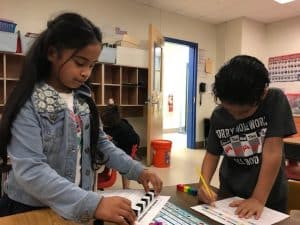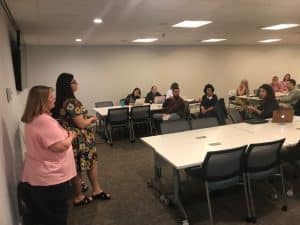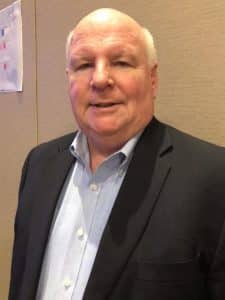New Hampshire’s Work Study Practices – A Five-Year Journey to Understand, Share, Scale, Deepen, and Meaningfully Assess These Critical Competencies
CompetencyWorks Blog
This is the first post in a 3-part series. It goes back in time to share New Hampshire’s initial approach to supporting teachers in embedding skills and dispositions like communication, collaboration, creativity, and self-direction into curriculum, instruction, and assessment in meaningful ways.
The History: Learning in the Trenches
For the past four years, many schools in New Hampshire have been grappling with how to support students in developing 21st-century skills—what New Hampshire refers to as the “Work Study Practices.” These critical competencies are necessary to be successful in whatever pathway learners choose to follow. This work has been replete with learning, for adults and students alike. As with anything of this nature, the more we do, the more questions arise. But through practicing and engaging in these work study practices ourselves, we are collectively prepared and ready, both through our mindsets and what we have learned, to continue to push forward, knowing in our core the impact that the development of these skills will have on our students, their learning, and ultimately, their opportunities.

Where Did “Work Study Practices” Come From?
This work initially began as part of a 20-year effort to bring student-centered, competency-based education (CBE) to New Hampshire classrooms so that our schools and educators could best serve each and every student equitably. Initially, CBE in New Hampshire focused on both core content and essential skills and dispositions. However, due to how different learning focused on “soft” skills proved to be, many New Hampshire policy makers, including those in the legislature, saw these skills as beyond the charge of public classrooms. Fortuitously, the chairman of the New Hampshire House of Representatives Education Committee, Rick Ladd, (a life-long former teacher and school principal), made the case that a new term, “Work Study Skills,” should be created, as these skills undergird student success with academics, helping students to work successfully at their studies. In this way, essential skills and dispositions in the form of work study practices found policy-level support.
Connecting with the Essential Skills and Dispositions Frameworks
Soon after, the New Hampshire Department of Education (NHDOE) began a process, led by teams of New Hampshire educators, with consultation from Sarah Lench of the Center for Innovation in Education (C!E), to define and create state-level work study practices (WSPs). Not surprisingly, these WSPs mirrored the definitions and developmental rubrics of the Essential Skills and Dispositions Frameworks that Lench had co-authored (Lench, Fukada, and Anderson, 2015). These developmental continua, focused on communication, collaboration, creativity, and self-direction, provided a framework that would become integral to the evolution of the WSPs in New Hampshire.
As New Hampshire continued to build out its CBE system, New Hampshire’s PACE (Performance Assessment of Competency Education) assessment and accountability effort was created, and became the recipient of the first-in-the nation waiver for innovative assessment practices from the United States Department of Education. Paul Leather, then with NH DOE, understood that these non-academic competencies were critical to student success in a competency-based system. The original five-part definition of a competency-based system stated that “Learning outcomes emphasize competencies that include application and creation of knowledge, along with the development of important skills and dispositions” (Patrick, Sturgis, and Pittenger, 2011). As we began to delve further into competency-based learning, we realized we had been focusing on the academic side of competencies, and that there was little consistency not only across schools, but also within schools regarding the WSPs. As our collective understanding of the critical importance of these non-academic competencies grew, we realized we had some work to do and began to roll up our sleeves.
This early recognition of where the field was in relation to the WSPs in New Hampshire was a critical catalyst for change. Although New Hampshire was an early adopter of CBE, it’s model did not incorporate personalized learning approaches and had remained more school- and educator-centered than student-centered. With a small grant, the NHDOE challenged three superintendents, known for their innovative practices in their districts, to attempt to move to a more personalized model. One superintendent, Brian Blake, of Sanborn Regional, in discussion with the district’s curriculum director, Ellen Hume-Howard, recognized the innovative teamwork being led by Jon Vander Els, principal of the Memorial Elementary School. With a small grant, Jon and four teachers, with support from authors Dave Lash and Grace Belfiore from Next Generation Learning Challenges (NGLC), began exploring specific components of the MyWays Framework related to metacognition and student agency. This had a tremendous influence on the participating teachers, their students, and those supporting the work. The understanding of what a focus on these deeper learning competencies meant for teachers and students was significant. This example, from Terry Bolduc, a 5th-grade teacher from Newton, New Hampshire, sheds some light on her takeaways and the greater takeaways of the team.
All of this early work reinforced to the state-level team that, to be successful, systems change had to be a groundswell effort from teachers supported at the building, district, and state levels. The C!E, in partnership with the NHDOE, enlisted interested schools and teachers to participate in course modules, developed by 2Revolutions, based upon the aforementioned Essential Skills and Dispositions Frameworks. This course provided teachers with guided opportunities to explore, develop, and reflect upon their comfort, knowledge, and understanding of their own skill level related to communication, collaboration, creativity, and self-direction, as well as to better understand the metacognitive practices that weave throughout all of them. This last part (metacognition) would prove to be a turning point in our approach.
We realized pretty quickly after the first year that we had to rethink our initial approach of having teachers engage in this learning strictly through an on-line course. Concurrently, the New Hampshire Learning Initiative (NHLI) was formed and began to actively support districts and schools in innovative, competency-based, and personalized learning. NHLI began to shift toward a hybrid model, one which combined a mix of in-person and online content.
Participating teachers and teams found the work to be profound for themselves and for their students. (For a glimpse of what that work looked like early on, read the first, second, third, and fourth articles in this series on the CompetencyWorks blog about Memorial Elementary School in the Sanborn Regional district.) Our learning literally started in one or two classrooms in a school, and as part of the support provided, we helped teachers and building leaders consider how they could diffuse what had worked and what they had learned from their practices, and the best way to share this with others.
The question of scale was soon being considered by districts. Epping School District, one of the original four PACE districts, had been involved in the WSPs effort for the first three years and had close to 30 teachers and administrators involved in one of three cohorts over the three-year period. Epping’s approach was to have this very knowledgeable team take on the rollout of implementation across the district. Sarah Kiley, the district lead for WSPs shared this journey here (with coauthor Jonathan Vander Els). Epping School District’s approach, one which stressed developing teacher leadership and ownership of the process, has become a model that we have shared with many other districts as they grapple with how to best seed and nurture the WSPs, until ultimately they have flourished into an integral component of a school’s or district’s system of learning.
Scaling: Setting Guardrails and Sharing Learning
As we moved forward in our support of teachers, we recognized that we had to put some guardrails in place, and the Essential Skills and Dispositions Framework became those guardrails. We used the term “guardrails” to recognize the importance of having a specific, research-based resource that would frame our thinking, but also that the learning based upon the resource would not be lock-step. The Frameworks would guide the learning, but the real learning for teachers would happen in their classrooms.
This was framed through five entry points: Instruction, Assessment, Professional Capacity, Conditions, and Innovation. The first two—Instruction and Assessment—tended to be where teachers focused. Professional Capacity tended to be a space for school-building leaders (how would they grow this work within their school), and Conditions (policies and context) tended to be the focal point of work at the district level. We also left open, with the fifth entry point, the idea of “Innovations.” We wanted teachers to feel free to explore where their interests happened to be. This ended up being where some of our greatest learning occurred.
After determining an entry point, teachers were then asked to “test” a hypothesis related to something they thought might make a difference for their learners within these essential skills. The resulting efforts produced rubrics, goal-setting exercises, explicit instruction of one or more of the WSPs, and explicit inclusion of one or more of the WSPs throughout a unit. All participating teachers (about 75) came together at the end of the year to share their learning. This became one of the strongest aspects of our approach, as participants borrowed ideas and artifacts from one another to assist in deepening their work with their own students in the coming year.
We recognized that with all of the learning happening across many different schools, we had a tremendous opportunity for learning and sharing. Each year, we’ve had a “Work Study Practices Symposium,” a place and time where anyone engaging in the work, or even those who might be interested in engaging in the work, have come together to share resources and learning, ask questions, and engage with this community of practice. The symposium has been an incredibly effective way not only to synthesize the collective learning together within our community of practice, but also to seed the next round of innovative approaches to deepening practices within classrooms throughout New Hampshire.
“It was an extraordinary gift to see how different districts and schools have entered and grown their work with the Work Study Practices,” said Sarah Lench in her reflections on attending the symposium. “Yet despite the diversity in approaches across sites, I saw a common theme: that educators who are truly lit up and inspired by the Work Study Practices are not simply redesigning instructional units or assessment tools; they are reconceiving their relationships with their students, how students are invited to show up in a classroom, and what we collectively believe they can do. And that energy is contagious across the community of practice.”

Through these efforts, we are building a community of practice that allows teachers who are engaging in similar types of work to have a learning community to share with, lean on, and learn from. It has been one of the strongest professional development opportunities teachers have engaged in because the learning is ongoing for the adults and the students, and the results of their efforts are tangibly realized within their classrooms.
As more and more schools and districts come into this work, we have provided even more opportunities as entry points. Typically, a district (or school) may start with a school team in which an interested group of teachers comes together to learn. Through this process, as we’ve described, they develop a deep understanding of “the why.” This then translates into their collective plan to scale the work across the district. In most cases, districts have chosen to take it slowly, building understanding and consensus to move forward together in a meaningful way. One district administrator noted that although it has taken longer, it will stick. In the past, when we may have changed the words of what we were “grading,” there was no understanding for our teachers, parents, or students. Now, we have stakeholders that truly understand the work and are working hard at making it meaningful in the classroom for kids.
The next post in this series explores the role of metacognition in developing these critical competencies and how teachers began to utilize metacognition as the foundation to integration and growth.
Learn More
- Recognizing the Critical Importance of Metacognition
- New Hampshire’s Work Study Practices – Equity and Assessing For Growth
- Habits of Mind and Learning New Ways of Learning at Journey Elementary

Jonathan G. Vander Els directs innovative, competency-based projects for the New Hampshire Learning Initiative and is co-author of Breaking With Tradition: The Shift to Competency Based Learning in PLCs at Work (Solution Tree, 2018). Formerly, Jonathan was a principal in an elementary school recognized nationally as a model professional learning community and competency-based school. Jonathan has consulted, coached, and presented at conferences and institutes throughout the United States, and lives with his wife and three children on the NH Seacoast.
 Ellen Hume-Howard is Executive Director of the New Hampshire Learning Initiative. In this role, she supports NHLI’s vision to assist New Hampshire schools and districts to deepen their innovative practices in education and improve learning for all students. Ellen has also worked with state and national experts to design a competency assessment program using performance assessment for state accountability. Ellen currently serves as the curriculum director for the NH PACE project.
Ellen Hume-Howard is Executive Director of the New Hampshire Learning Initiative. In this role, she supports NHLI’s vision to assist New Hampshire schools and districts to deepen their innovative practices in education and improve learning for all students. Ellen has also worked with state and national experts to design a competency assessment program using performance assessment for state accountability. Ellen currently serves as the curriculum director for the NH PACE project.
 Paul Leather is Director of the Interstate Learning Community for the Center for Innovation in Education. Mr. Leather’s background and experience in Education, Counseling, and Administration in New Hampshire spans four decades. He served as the Deputy Commissioner of the Department of Education in New Hampshire for eight years, and has also served for 18 years as the Director of the Division of Career Technology and Adult Learning for the Department, overseeing numerous statewide initiatives and programs. In 1997, Mr. Leather began a journey to create a state model for competency-based education. This effort resulted in the development and implementation of the NH student mastery model now in place as part of New Hampshire’s system. More recently, he led the development of a first-in-the-nation next generation educational accountability model, called “Performance Assessment of Competency Education,” or PACE, approved as a pilot program by the US Department of Education, starting with four New Hampshire districts in March 2015. For the Center for Innovation in Education, he co-leads the 8-state Interstate Learning Community and the Intermediary Organization Learning Community with Gretchen Morgan.
Paul Leather is Director of the Interstate Learning Community for the Center for Innovation in Education. Mr. Leather’s background and experience in Education, Counseling, and Administration in New Hampshire spans four decades. He served as the Deputy Commissioner of the Department of Education in New Hampshire for eight years, and has also served for 18 years as the Director of the Division of Career Technology and Adult Learning for the Department, overseeing numerous statewide initiatives and programs. In 1997, Mr. Leather began a journey to create a state model for competency-based education. This effort resulted in the development and implementation of the NH student mastery model now in place as part of New Hampshire’s system. More recently, he led the development of a first-in-the-nation next generation educational accountability model, called “Performance Assessment of Competency Education,” or PACE, approved as a pilot program by the US Department of Education, starting with four New Hampshire districts in March 2015. For the Center for Innovation in Education, he co-leads the 8-state Interstate Learning Community and the Intermediary Organization Learning Community with Gretchen Morgan.